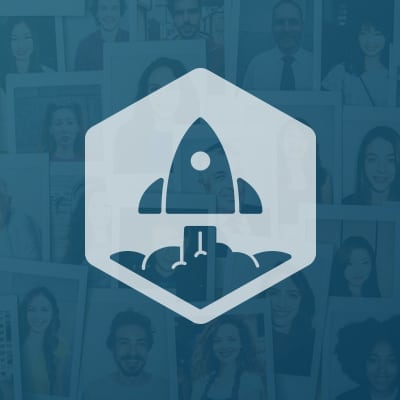At SaaStr, we love talking about how to sell to SMBs because things are always changing and there’s always something new to learn. Keri Gohman, President at Xero Americas, takes the Main Stage with Alex Fala, CEO at Vend; Amit Mathradas, GM & Head of Small Business North America at Paypal; and Matt Rissell, CEO at Tsheets.com, to talk about the non-obvious lessons they learned selling to SMBs.
Alex, Amit, and Matt are all believers in looking at data and metrics, especially Matt, to gain a deep understanding of what works and what doesn’t. You absolutely need a system or tool for analytics. But remember: don’t let your analytics stifle creativity and the courage to try new things. They also dive into where to find the best hires and how to really speak your customer’s language and hit them with the right message when it counts.
And if you haven’t heard: SaaStr Annual will be back in 2018, bigger and better than ever! Join 10,000 fellow founders, investors and execs for 3 days of unparalleled networking and epic learnings from SaaS legends like Jyoti Bansal, Dustin Moskovitz, Jeff Lawson, and Michael Pryor. If you don’t have tickets, lock in Early Bird pricing today and bring your team from just $749! (All ticket prices go up September 1st.) Get tickets here.
TRANSCRIPT
Announcer: Xero proved you can build a unicorn SaaS rocket ship selling software to SMBs, even from New Zealand. Please welcome Keri Gohman, President of the Americas, Xero.
Keri Gohman: Hey, guys. I’d love to bring out my panelists as well. Good afternoon. We’ll introduce these guys in just a minute. Here we go, come on out.
Great. Hey, guys. We’re going to spend the next 45 minutes talking all things small business, how to design products, how to reach small businesses, and how to engage small businesses.
Now, for those of you that serve this particular segment, you know how challenging that can be. These guys are diverse, they are incredibly time starved, and in many cases, really need to take advantage of the software that we all provide.
I wanted to, as we talk to this panel, put together a group of folks who are in different stages in their company’s evolution. We also wanted to have a conversation, if you noticed the title, that is not so obvious. That really focuses on things we’ve tried, succeeded at, tried failed, tried pivoted, and tried again. That’s really the conversation that we will have.
I’d love to introduce Matt Rissell to you. Matt is joining us. Matt is the CEO of TSheets. TSheets is a time tracking and a scheduling software. Matt is really in a growth phase. 40,000 customers, as well as 500,000 users, about 200 employees out of Boise, Idaho.
We also have Amit Mathradas. Amit’s joining us as the General Manager and Head of North America Small Business from PayPal. We’re excited to have Amit here. A couple of you might have heard of PayPal, an online payments provider and definitely at scale, 197 million consumer relationships, 15 million small business relationships, about six million of those in North America alone.
PayPal’s really seeking to democratize financial services. Big mission, lots of scale, 18,000 employees worldwide.
Then last but not the least, we have Alex Fala. Alex is the CEO of Vend. Vend is a software focused on POS for the retail segments. A very verticalized strategy focusing on helping businesses build and thrive in their organizations, but also have more fulfilling lives. About 20,000 stores, and about 200 employees, and very much in a growth phase as well.
Let’s welcome our panelists tonight.
[applause]
Keri: Let’s get started. I wanted to just note that we’re not just here because we are all at different phases in serving small businesses. We’re also here because we’re part of an ecosystem together.
Many of you know of Xero as an accounting software. One of the things we also are is a platform bringing together an ecosystem of software providers who are serving the small business segment to make it easier for financial management, to make it easier for businesses to be successful.
Both bringing together software providers and advisors, accountants and banks.
We’re all part of that ecosystem together and are all deeply integrated. You’ll hear how that strategy impacts pretty significantly the way we all go to market. The other thing that’s notable is we’re really deeply integrated.
Alex, I hope you don’t mind if I share this story. Alex was so committed to integration with PayPal that they actually threw their founder off of a plane to prove that you can take PayPal payments from literally anywhere using Vend software. Was it successful?
Alex Fala: He’s still alive. It was fun for the rest of us.
[laughter]
Keri: It’s excellent. We don’t recommend that as a tip for you guys to take away from today’s session, but an interesting anecdote.
Let’s go ahead and jump in. Matt, I’d love to talk to you about designing products.
One of the things I mentioned is just the diversity of the small business segment, how challenging it can be to serve? When you’re designing a product, how do you make sure you get that right so that you get enough scale to build a business, but also meet the unique needs of business owners?
Matt Rissell: Good question. Keri, thank you for having us. It’s great to see everybody. Designing a product, first, I mean, obvious you have to solve a problem. When you first go to design a product for SMBs, it’s like, “OK. What problem am I going to solve?”
The second thing is, I would say, look, small businesses, I don’t think, want to try to implement a system that tries to do absolutely everything.
My recommendation always is…The ones that I actually think are going to win in the marketplace are those that it solves one problem. They’re the best in breed solution. What they do is they seamlessly integrate with other applications that provide a solution.
When you put yourself in the shoes of a small business owner, I mean, big companies like massive Fortune 100 companies, they can’t implement systems that do everything. It’s a disaster. Why would you think that a small business can?
The ones I think are really going to win and win in the SaaS space are those that are best of breed point solution with seamless integrations.
Keri: Absolutely. Alex, any advice from you on this front?
Alex: Yeah. I would echo what Matt said about being part of a healthy ecosystem. The thing I would add to it, though, is you also need to think about which customers you’re going to target, which is kind of obvious.
We often talk about product market fit as this one time event and it’s magical and when it happens, it’s kind of, “Yay, we’re done, we can just grow.” It’s also something that you need to sharpen over time.
At Vend, we experience that. We started out as a very simple point of sale for pretty much anyone across any vertical that needed that.
As we went upmarket and discovered more profitable customers and other customers that we wanted to serve, we realized they had very divergent product needs and so we had to make a choice.
For us, that was saying we’re no longer going to be hospitality POS, we’re going to focus completely on inventory based retail. I think you really need to keep thinking about that all the time.
Keri: How to focus, do that one thing exceptionally well.
Amit, you guys do a lot of things at PayPal. How do you focus, how do you design products when you have so much that you’re doing?
Amit Mathradas: One of the things that both my colleagues have mentioned are looking at data, looking at how you want to go interact with the market and serve that base.
The one thing at PayPal, Keri, you mentioned we have 18,000 employees, but most of them actually sit in the customer support and sales. Keeping that open loop and that open feedback is in our opinion critical.
As you guys are designing, building, and expanding on products, the number one thing to make sure you’re doing is building it from the outside in and having that open feedback loop on what is it that a customer really wants and how do you continue to accelerate that as you’re getting that feedback.
Keri: Now, as you’re implementing things, one of the things we talk a lot about at Xero as well is how do you test things before you go actually to launch, before you launch it to six million people.
Alex, we’ve heard about this idea of big bets versus small bets, do you guys subscribe to this methodology or how have you used that?
Alex: Yeah. It’s really important to make big choices around strategic direction as I mentioned. On a day to day, week to week, quarter to quarter basis, we’ve certainly got a bias towards doing small things, thin slices, testing and seeing how it goes.
At the same time, we’re always, though, trying to check ourselves and make sure that we’re applying the courage that you need to take big choices around where the product’s going. For us, it’s a bit of a balance, but certainly a bias towards small things that you can test and get real data around.
Keri: Matt, how do you know if you get that small thing right, because I know you have pushed about on this in the past?
Matt: I’m sitting there in your shoes and everybody’s heard of The Lean Startup. I mean, everybody has. I can tell you though, that of all the businesses that I actually talk to, and the startups and the SaaS companies out there that actually implement the principles are so small and it’s that simple.
Basically, you draw a line up on a board. You take a whiteboard, you draw a line on one side. You put on one side what’s working, and on the other side you put what’s not working, and then you make a list. Here’s the kicker, is you have to be able to prove it.
In the TSheet story, it’s that simple. We read The Lean Startup. It took us from the startup that wasn’t going to make it. We had four miserable go to market failures, to the point where we ran out of money, we had to move into free space. We had like four and a half employees like the world was coming to an end.
We read that book and we did that. We wrote it out, what’s working, what’s not working. When we asked ourselves, “How do we know?” That’s when it got really fuzzy. It’s like, “Oh, well, I think this is working.” But the truth is we had no idea. Most of the things we thought were working, they weren’t.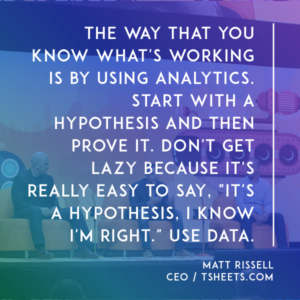
The way that you know is that you actually use the analytics. This is a SaaS conference. Take the time to put the infrastructure in, to actually find out the results of whatever it is you’re going to test. Start with a hypothesis and then prove it.
Don’t get lazy, because it’s really easy to say, “It’s a hypothesis, I know I’m right.” Use data.
Keri: That really changed the way you went to market. It sounds like it fundamentally changed your traction for success?
Matt: It wasn’t overnight, but there’s absolutely no question like that was the…That was it. It was back before all of these really great analytics tools were out there. What we did actually is inside of our application, we build what we call, we coined, the Lean Dashboard.
Basically, we started to gather all metrics from everything the customers were actually touching our product and as much as we could. It was rough. That’s how it started, so yes.
Keri: You home grew your own analytics platform.
Matt: To begin with, yes. That’s what we did.
Keri: Impressive.
Matt: We did. It was ugly, just ugly.
Keri: It got the job done, right?
Matt: Since then, we’ve taken it out to the desert and we’ve shot it and so it’s not around anymore.
Keri: [laughs] Nice. Amit, do you guys use heavy dose of analytics and testing at PayPal?
Amit: Yeah.
Keri: How do you make sure you get it right for your six million customers in North America?
Amit: That’s such a great question because there is no simple answer to it. The point, I think, that both Matt and Alex have made around testing and getting into it and looking at it from a small versus big bets is critical.
The challenge that I think all of us have in this industry is we are in the fast paced tech software SaaS based market.
What you’re testing and building today maybe irrelevant for four years down the road as new technologies come out. The methodology of really thinking about…We do this pretty well at PayPal, which is take core products, even invoicing, which is an old staple.
We’ve added features to turn it into mobile and One Touch, which allows a single sign on, check out to increase the speed. That’s the small bets.
The big bets are things like what we’re doing with Visa, MasterCard, what we’re democratizing, choice for customers, which you may have heard of, which will change the trajectory of payments. I think you have to look at it from both sides.
Keri: You want to add a comment?
Matt: I would just say, as a startup…I don’t know what everyone’s scale is here. As a startup, pretty much anything you do is a big bet. Find a way, be as scrappy as absolute possible, but find a way to minimum viable way to prove your hypothesis.
Keri: If you’re a startup just getting going, do you have any recommendations for a platform that you would say, “Hey, check out this analytics toolkit if you’re just getting going and don’t have the resources to home grow”? Did you guys all home grow some of those systems? Home grow?
Alex: Yeah, homegrown.
Keri: There you go.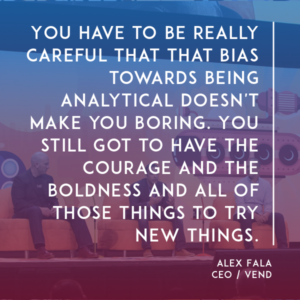
Alex: If I can just add a little bit, for a lot of us, it’s like cultural bias towards analysis as well. The thing I would add to some of what Matt said is you have to be really careful that that bias towards being analytical doesn’t make you boring. It still means you’ve got to try new things, right?
You get really analytical, and then the natural tendency is, “Now we’re going to analyze support tickets and verbatim of NPS surveys.” You just end up doing what people told you. You still got to have the courage and the boldness and all of those things to try new things.
Keri: Let’s talk about that. Talked a little bit about designing products. Let’s talk a little bit about how you reach customers. Alex, you talked about not getting boring. How do you get a customer interested? Particularly one that just doesn’t have very much time for you. They’re busy running their business.
Alex: It’s a lot of really obvious things around marketing tactics but since you said we’re going to do non obvious…
Keri: Do the non obvious. We don’t need to hear about that.
Alex: For us, the thing that we’ve really discovered is that the magic comes from deeply empathizing with our customers’ lives. Note that I say their lives, not the way they use our product.
If I think about that in our situation, our customers are retailers. They’re passionate about products. They’re passionate about shoes and clothing and that kind of stuff. They’re passionate about their team, running stores. During business hours, they’re doing all of that stuff they’re timed for.
The things that we’ve done to try and make them be more interested in us, I’d say a couple of things. The first one is, you just have to have some personality.
Keri: You don’t have any of that. [laughs]
Alex: I’m not speaking me personally, I’m saying on marketing, right?
[laughter]
Keri: I’m just joking.
Alex: You mentioned the jumping out of the plane. We had another piece of ad creative where we compared Vend POS, point of sale, to a Legacy POS, pile of s***. We were prepared to do those kind of things to stand out. I think that’s super important.
The other thing is, just make life easy for them. Again, there’s a lot of technical process things around having good trial processes, complementing that with content. Sometimes, the most obvious things are the ones you forget.
Our customers are focused on running their retail business during the day, which means you have to do demos after hours. Those basic insights can have material impact on the business.
Keri: Matt, any thoughts on how do you actually get customers’ attention? How do you figure out how to reach them?
Matt: One, I really like what he said, because as far as empathy is concerned, truly you have to understand and put yourself in the customer’s shoes. Everyone’s in TSheets. You guys do time tracking, that is so freaking lame, except when you’re this small business owner.
Let’s say you’re a painter and you have 20 employees. Let’s say you were a mover, we were just talking about that. You have 20 employees. Your margins are really tight.
What’s the single largest line item on your P&L statement? That’s a real question.
[laughter]
Matt: Labor, right? It’s labor. You’d be thinking about payroll products and that kind of thing. All they do is they just aggregate information. They don’t actually help you control or help you manage or help you run your business.
The one tool that helps you control your single largest line item in your P&L, is a time tracking tool. You have to understand. They come to us, and they’re actually emotional about a time tracking system.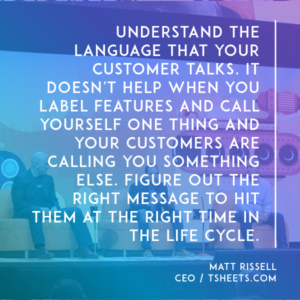
The other thing is this, is understand the language that your customer talks. It doesn’t help when you label features and you call yourself one thing and your customers are calling you something else.
Figure out the right message to hit them at the right time in the life cycle because they may be searching for something. Obviously, you guys already know this. Searching for something that has nothing to do with time tracking but they’re having an employee issue, they’re having a labor issue. Meet them there and with the right message.
Keri: Let’s talk about that idea of contextual marketing. I know it’s a bit of a buzz term but it’s the idea of finding someone at that moment where they’re searching for, “I’ve got a problem.” How do you do that?
Matt, you talked about data, do you use that? Do you use data and analytics in trying to find those customers?
Matt: I don’t know. Maybe Alex thinks it’s boring but we use data for everything.
I’m not kidding you. We test buttons, like a color of a button to see if it makes a difference. The funny thing is, it really does make a difference. It’s weird. We use data and we test based on markets.
Obviously, it’s the basics. We try not to get too ahead of ourselves. It’s like, how do you win Super Bowls? You block and you tackle really well. You stay in the game. That’s what we do.
We constantly are leveraging our pay per click campaigns, using that as our testing base to really drive our strategy on SEO.
Keri: Amit, how do you find customers when they need you? You guys probably have tons of data flowing through your system?
Amit: Yes, we do. The data also has to be translated into something that is meaningful. I think both Matt and Alex have coined or have been talking about, “Don’t have analysis paralysis.” Eventually, the feedback that you’re getting directly from customers is a big one. Also understanding…I’ll give you an example.
We had a product that came out, which was around a mobile app for business. The whole idea was, “Hey, how do we just get you reporting?” Customers were asking for it. Tell us the basics of running a business.
What we found is, if you take that product, and we included our invoicing in that, and so now you can actually just fire off an invoice to anybody out there and include One Touch.
What it’s starting to do is the engagement has gone through the roof, because the product has turned from being a business tool to a run the business tool. There’s a big difference in how those two things come together.
Keri: This idea of using data and analytics and combining that with fun and human empathy, that’s a really unique set of skills.
How has that evolution changed the way you hire the type of talent that you need, maybe even the location of your business? Has that evolved, what your strategy is around human capital, or around your people?
Alex, do you want to take it and then…?
Alex: Yes, sure. We’re all looking at each other because it’s a really, really tough question.
[laughter]
Alex: I don’t there’s any magic to that other than, from a personality perspective, I think that comes through from your culture and being really clear about your values and hiring people who are going to fit with that, and who’re really going to be able to speak in your language.
On the analytical side, I think Matt’s really role modeled having the obsession around that. We very much try and do the same, but unfortunately, I don’t have any magical answer on that one. [laughs]
Keri: It sounds like you also really spent some time thinking about your values and culture at the beginning of that interview process.
Matt, how about you, from a data perspective, how do you find analytic talent? Can you find great analytic talent anywhere? Do you need to be in San Francisco for digital talent, or here?
Matt: There are two different questions there. Do you have to be in San Francisco to find top talent? and I would say, absolute…I’m in San Francisco, and I love San Francisco, [laughs] everyone here’s fantastic. Almost as good as Idaho, if you haven’t been.
I think you can find brilliant people anywhere, I really do. It doesn’t matter, the city, and that’s the truth.
There are definitely advantages to being in San Francisco. There are lots of pros to being here. At times, I wish I was here more often, but the truth is, there are a tremendous amount of pros of being outside of Silicon Valley and San Francisco. We love that we’re headquartered in Boise, Idaho, of all places, a new tech center.
The other questions is, how we hire them. It’s funny…
Keri: How do you hire for data? How do you for analytic talent, in particular, the kinds of folks that are doing the marketing that you really talked about?
Matt: We look for really smart people that care about what they create. They truly want to do the best work of their lives. It doesn’t come from external accountability, with…we have no management titles inside of TSheets at all, because I think managers are trying to constrict and trying to manufacture authority.
We want people that really…it comes from within in, and they want to do the best work of their lives. They have a natural aptitude to have attention to detail, so they actually have a desire to put excellence into everything.
It’s funny, an analytical person that really cares, will actually pick up trash off of the bathroom. They can’t stand to leave the bathroom with a paper towel. Of course, they wash their hands, but they do, they put excellence into absolutely everything. Those are some of the things that we look for.
Alex: Keri, if I can add a little to that Bay Area question, I actually think it’s something that, when you’re targeting SMBs, many companies need to confront, because this is an expensive place to live.
For us the challenge has been, there’s a lot of…Matt’s right, there’s great talent everywhere in the world, but there’s a lot of been there done that talent in San Francisco, and you’re trading that off versus, in many cases, the reality that you have to pay 50 percent more for a sales person in this market.
I think that is tricky, and as I said, I don’t really have a great solution other than to say, we’re hiring in Auckland, Melbourne, Toronto, and London, and they’re great cities, and I’m sure Boise, Idaho is, as well. [laughs]
Amit: Yeah, I think, you guys, it comes down to this formula, and the formula is, what is the caliber and type of individual you’re looking for, and you will find them everywhere, in this country, worldwide.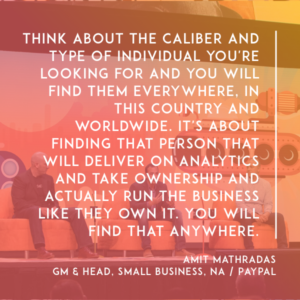
It’s about finding that person that will deliver as analytic, as well as the fact that they will take ownership and actually run the business like they own it, and you will find that anywhere. I think that’s a critical piece.
Keri: It’s interesting, Alex, you brought up sales and Amit you talked a little bit about the environment you create around the person you hire. We talked a lot about data and analytics, and we’ve talked about how you use that a little bit in the marketing context, as well.
Is there a role for salespeople in a world where there’s tons of data, you can identify the moment of need that a customer may have, is there a role for physical sales? Amit, I’d love to hear from you on that.
Amit: My take on this is, absolutely. As the world’s turning digital and contextual is becoming a bigger piece of the puzzle, yes, there’s absolutely a role for contextual.
Contextual helps you translate those sales a lot faster in a certain part, but don’t forget that depending on who you’re targeting, so if you’re going after a transactional customer, whether it be small business or consumer, contextual is big.
As you start moving up the food chain and want to start having conversations around the life cycle, not just a single product, then that’s where the beauty of sales comes in, and the ownership and the account management.
I think as you all are looking and growing and deciding which channels to use, contextual, to me, is one important piece, but it’s not the only piece.
Keri: What do you guys think?
Alex: For our business, I 100% agree. I think it really does depend on the nature of your product and the customer you’re working with, so it all starts again from that empathy.
For us, our customers are not technologists. They’re time poor, and our platform is what they use to run their business, so it’s a big risk. To put all those things together, you need to put a human face on it to get a sale done.
Keri: What do you think, Matt?
Matt: I actually agree, as well, and guess why I agree. We tested it.
[laughter]
Matt: It’s true, I’m not kidding.
Keri: I couldn’t have guessed that.
Matt: In fact, we actually tested different approaches, and different timing of salespeople and where to enter them into the process, and which ones convert the highest, and then tied it to LTV, we did. [laughs]
Keri: Have you ever tried a type of sales that wasn’t successful? I know, one of the things you shared with me is that you guys even tested outbound selling versus feet on the street. Talk a little bit about some of your lessons there.
Matt: Our second miserable go to market failure was…my background was in enterprise sales and business to business sales, and so when our first go to market failure didn’t work, I’m like, “OK, here’s what I’ll do, I’ll go get a stable full of thoroughbred sales people, give them a calling list, dial for dollars,” and that was going to be our demand generation.
While we had some success, there was no way the return on investment was going to come soon enough, and it wasn’t going to scale. It couldn’t be an outbound sales team that created the demand, and so that didn’t work. [laughs]
Now, our salespeople are different. We have those that come in, and they actually sign up for TSheets and then we have salespeople engagement.
Keri: Really, the power of testing and really unlocking which model works for small businesses, but I think a lot of agreement around the human side of salespeople to help small businesses move forward, which is really powerful.
We’ve talked a little bit about designing products, we’ve talked about different methodologies for reaching customers, and the balance of marketing, analytics, and digital with physical salespeople.
How do you actually keep customers engaged? What do you do to design the next set of products that a small business owner might want?
Amit, I’d love to hear a little bit about how do you ensure that you keep a small business owner who’s tried the product, continuing to come back and stay with you?
Amit: One of the key things that I’ll often see as I talk to a lot of our customers is, keeping a customer engaged, obviously you’ll hear things like content and life cycle management, and keeping them and talking to them about all their aspects of their business, check, I think that’s basic.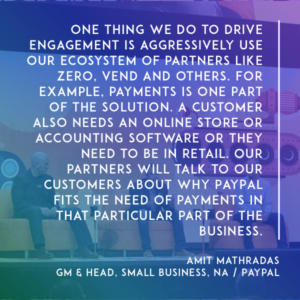
The other thing that we do aggressively is use our ecosystem. What I mean by that is, think about a product, so we’re in the payment space, we want to do payments. For a customer, payments is one part of the solution, first they need an online store, or they need accounting software and they need to be in retail.
For us, the way we drive engagement is all about, how do I reach out to my ecosystem and have our partners, such as Xero, Vend, others out there, Big Commerce etc., talk to the base about, “Here’s why PayPal actually fits the need of payments in this part of the business, which is what you’re looking to me for.”
I think that really helps accelerate the go to market and the engagement you get, because it’s a double sided network. It’s PayPal talking to them, but also the partners where the PayPal product is used talking to them, and that comes together.
Keri: Yeah, and probably builds a bit of credibility along the way for PayPal and for your partners as well, which is really powerful.
Matt, how do you make sure that when you’re developing that next product, you protect yourself against taking that big bet? You’ve talked a lot about the fact that every bet is a big bet, how do you ensure that the next thing you try is right?
Matt: We take the same approach to when we develop features, and it’s the truth.
The base core, when we first started, it was time tracking and basically, mainly for hourly employees for payroll. We knew that we needed to launch a scheduling system as well, because they’re so closely intertwined, but we weren’t sure exactly what that product would look like, etc.
What we did is, we launched a very minimum version of scheduling. What it did is, we tested it and then we used not only customer feedback, but we actually watched.
You guys use SaaS products, put the infrastructure inside of it, and watch what they do, and watch what they actually use and they don’t use, and then interview them for what problem are you trying to solve.
The result of that is really interesting actually, for those of you that are into scheduling. [laughter]
It’s really interesting, because there were two problems, fundamentally, that they were trying to solve. They were trying to solve both, “OK, I have a restaurant, and I have a bar staff and a wait staff, and I need to schedule my employees,” that was one problem.
The other one was service based companies like plumbers. “I have a whole list of jobs and I need to schedule them out among all of my employees.” Both called scheduling systems, two fundamental different problems, but what’s cool is, because we detected that early on, about halfway through the development cycle, we actually killed both birds with one stone.
Keri: That’s fantastic, and I think what you’re highlighting is not just the data, but also really listening and seeing what customers are doing and that human component, as well.
Matt: Gotta be both.
Keri: Alex, how about you?
Alex: I have really not much to add to what the guys have said. It’s a combination of analytics and being human, I think, for us.
Keri: Yeah, absolutely, it’s essential.
One of the things that I’ve heard a lot about in small business and serving small businesses, is the idea of providing content. Content based marketing, communities, where we send out general information about starting a business and that kind of thing.
Do you guys use communities? Is there any value in them in keeping a small business engaged? What have been your lessons around that? Matt, do you want to start?
Matt: Yeah, sure. If you can develop a community, especially if they absolutely love your product, do it.
To be honest with you, we haven’t done as good of job as we could have, but the things that have worked for us are, when it’s actually short, interesting descriptions or videos about your products, and as you guys know, it doesn’t ever hurt to be looked at as an authority in your space.
What we’ve done is we’ve spent a lot of time actually building people’s not only personal brands, but actually their true understanding of the problem that they solve, they’re looked at as the industry experts, and so when they talk, our customers really listen.
Again, it’s based on, by vertical, so yes, and we plan to invest there a whole lot more.
Keri: What I hear you saying is narrowing in on content that is relevant to your product. It didn’t sound like you’re providing just general information but a lot about what you do. Alex, how do you use education?
Alex: Yeah, so very much along the lines as you said. We have something called Vend University, which started out as something we were trying to build content to help retailers get better at retailing. Surprise, they knew more about their business than we did most of the time.
We’ve evolved that over time. There’s still some of it for retailers who are starting up, but now it’s much more around product education. I guess the way that we build the agenda for that is often out of support tickets.
What are they giving us feedback on? What do they not understand how to use?
A lot of it’s about customer success, but it’s also about reducing our cost to serve. Now we have thousands of hours viewed on Vend University per month, so I think it’s doing some good.
Keri: It sounds like your users are actually generating your content, because they’re telling you what they need to know more about, which is a really powerful feedback loop.
Alex: Yeah, absolutely. I think we’re probably similar to Matt in terms of we think about this a bit, but there’s heaps of opportunity to do more, like we have community support and all of those good things.
I think there is a huge opportunity for us to leverage off the natural sense of community that our customers have and really amplify that. It’s certainly something to do more of.
Keri: Small business owners are definitely the best networkers. Amit, any thoughts on it at PayPal?
Amit: Yeah, one piece I would add, though, is content is obviously important, but also know why your customers are coming to you. What I mean by that is, look, at PayPal, we’ve been fortunate enough to have tremendous scale, and it also brings a lot of credibility.
The other side to it is a lot of customers come to us with and ask of, “Tell me, where do I go for different things?”
That community aspect of, “Hey, come to PayPal, we’ll talk to you about payments,” but when your question turns into, “Where do I go for an online store? Where do I go for accounting?” we have already done the hard work of partnering and curating and bringing that forward.
I think that level of content, and that level of communication, really amplifies, not only your product and brand, but also why these customers depend on you.
I think that helps elevate your own business.
Keri: I think one of the really cool things that you can do as you get the scale that you’re talking about, Amit, is to really bring together those business owners to help educate each other. I know we all do that in our businesses, really in our specific areas as well, which is a really, really cool thing.
Last question. A lot of us have had debates about, “How do you know how you’re doing?” Once you’ve designed for small business, you’ve engaged them, you’re having a deep relationship, hopefully, with that customer, how do you know how you’re doing?
A lot of lore about Net Promoter and whether or not that’s a good way to measure, or something else.
I see everyone smiling. Do you guys think Net Promoter is a good useful measure for understanding how you’re doing with small businesses, or is there something different that gives you a good gauge on how you’re performing?
Alex, do you want to start?
Alex: Yeah, sure. There are a lot of things that we measure to see how we’re doing with our customers, on Net Promoter specifically. For us, it is culturally really important to put a number on customer delight.
We want to provide something for our customers that they truly love. Like many of you, we have a lot of analytical people in our business.
If you don’t put a number on it, it doesn’t get managed the way it should, and it doesn’t get to the top of the priority list the way that it should. Having said that, is NPS perfect?
No, I don’t believe so, and I’d really encourage people to look below the standard question, and below the standard methodology, and understand the things which really drive your business.
We do quite a lot of analysis around what feedback we get from NPS correlates with churn, and with actual word of mouth. I just encourage people to think a bit deeper than the headline number.
Keri: Anything else that you guys use to figure out how you’re doing?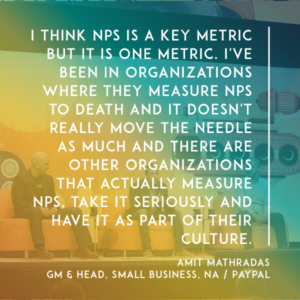
Amit: I agree with you. I think NPS is a key metric, but it is one metric. I’ve been in organizations where they measure NPS to death, and it doesn’t really move the needle as much as you’d like, and other organizations that actually measure NPS, and take it seriously, and have it as part of their culture.
I think that’s an important piece. Today in the world of social, you will find out pretty quickly how you’re doing. People will text you, tweet you, Facebook you on, “Hey, you’re doing great, you’re doing badly.”
I think all those things have to be taken into account when you’re measuring how you are serving your customer versus just one metric, but it is an important metric.
Keri: Anything to add?
Matt: Well, you need multiple metrics, there’s no question. One thing that I will say is the NPS score. You will be tempted to create a bullshit NPS score. You will. You’ll be tempted to do it, because it’s something that you control how you do it internally, and then people will leverage that as a marketing tool somehow.
I think it’s crazy, and I think long term that bites you, because you really don’t know how your customers are reacting to your product, or whatever it is you’re trying to…you’re just lying to yourselves.
You’ll start to make decisions, by the way, and drink your own Kool Aid. I highly recommend that you create your NPS score by using the best practices, the most academically correct ways.
There’s a few different ways to do it, but just make sure that you do it with some level of integrity. Otherwise, if you don’t, I won’t care, but you won’t have the feedback to make good decisions. I think that’s the core purpose of it.
Keri: Yeah, absolutely. Any last words of wisdom that any of you want to jump in?
Alex: Yeah, sure, I’ll jump in. I think one thing that I touched on, but we didn’t talk a lot about is culture, which for me is the not so secret weapon of every company, but particularly in SMB. For small business owners, business is personal and they want to know that you care.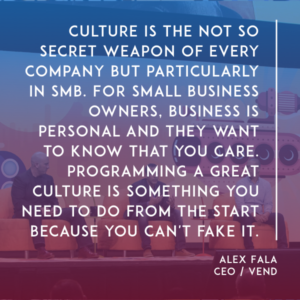
You’ll be hiring a lot of young people into sales, and support, and CS type roles, and they’re going to need something to get them through the ups and downs of their careers, and also your business. For me, programming a great culture is something you need to do from the start, because you can’t fake it.
Keri: Totally. Any last…?
Amit: My golden nugget would be everyone here has started a business, or been in a business, that is there to serve a need that exists in the market.
The one thing I would always say is make sure you’re staying on top of that need, and make sure you keep that feedback loop open, and know what you’re doing and how it’s progressing is actually meeting your original goals, and what the customer’s asking for and how things are shifting.
It’s very easy to get a little bit self absorbed into, “This was a great idea, and I want to keep working on it,” and then find out the things around it have shifted. That feedback loop serves us well and will hopefully serve you guys well.
Keri: Matt, any last thoughts?
Matt: I would say this. Use data, like actually use data. Stay focused. Pick one thing and do it really, really well. The third thing that I would say, and all the stuff that I’ve said about data, I would counter it with this, is that there are so few things in this world that you can control. Think about all the things inside your business that you cannot control but the one thing that you can is every single interaction with your customer, you get to choose how you treat them.
Keri: Absolutely. Powerful. I think that you guys heard some really important points as we went through. Matt you did such a great summary. I think it is really about that human component at the end of the day, that you’re really touching someone’s life, you’re helping them be successful and that you want to balance that with making sure that you’ve got great empathy backed with great analytics and really leveraging your ecosystem and partnerships.
Guys, thank you so much for being on our panel today. I hope this was helpful for you guys.
Matt: Thank you, Keri.

